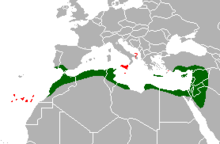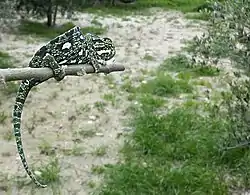Common chameleon
The common chameleon or Mediterranean chameleon (Chamaeleo chamaeleon), together with the African chameleon, C. africanus, is one of only two extant species of Chamaleonidae with a range that extends into Europe.
| Common chameleon | |
|---|---|
.jpg.webp) | |
| C. c. recticrista Dana Biosphere Reserve, Jordan | |
| Scientific classification | |
| Kingdom: | Animalia |
| Phylum: | Chordata |
| Class: | Reptilia |
| Order: | Squamata |
| Suborder: | Iguania |
| Family: | Chamaeleonidae |
| Genus: | Chamaeleo |
| Species: | C. chamaeleon |
| Binomial name | |
| Chamaeleo chamaeleon | |
 | |
| green: native, red: introduced | |
| Synonyms | |
|
List
| |
Subspecies
Four subspecies are currently recognized:
- C. c. chamaeleon (Linnaeus, 1758) – the nominate subspecies
- C. c. musae Steindacher, 1900
- C. c. orientalis Parker 1938
- C. c. rectricrista Boettger, 1880
Description
The average length of the common chameleon is 20–40 cm (8–16 inches), with females often being substantially larger than males. The colour of the common chameleon is variable, between yellow/brown through green to a dark brown. Whatever the background colour is, the common chameleon will have two light coloured lines along its side. It has a small beard of scales and some small hard scales on the top of its back. Many assume the color changes undergone by the chameleon are a result of its attempting to camouflage itself, when in reality the chameleon changes its color as a response to light and temperature stimuli and as an expression of its emotions (like chameleon body language). Often when caught for analysis, the chameleon may turn a dark color. Their colors are also important for intraspecies communication, especially during the mating season.[2]


Ecology
Diet
The common chameleon is insectivorous, capturing insects by stealth and the rapid extension of its long tongue which has a terminal pad which grasps and adheres to the prey. Adults are known to eat young chameleons and have been observed to eat fruit.[2]
Behaviour
The common chameleon like others of its family enjoys an arboreal habitat, scrambling about in trees and bushes with feet that have five toes, in groups of two or three on each side for grasping branches. It also uses its prehensile tail to maintain balance and stability. Movement is usually leisurely, often with a slight swaying motion to avoid detection by predators. The animal can move more rapidly when involved in a territorial dispute.[2]
Reproduction
The common chameleon is usually solitary, maintaining a territory and only tolerating members of the opposite sex during the mating season. It is sexually mature within one year and the females produce one clutch of eggs per year. Larger females produce more eggs and are more attracted to males who will fight over a female. The mating season for the common chameleon is from mid-July to mid-September. The animals descend to lowers levels of vegetation or to the ground to search for a mate. The eggs are laid in the soil and take from 10–12 months to incubate. Adult animals, especially males, will eat young that they encounter.[2]
Distribution
In Europe, it is only autochthonous to the Iberian Peninsula: southern Spain and Portugal,[3][4] Cyprus and the Greek island of Crete. Nevertheless, it has been successfully introduced into other Greek islands, Canary islands and Malta. In Malta, Jesuit priests are thought to have introduced this species around 1880 in a small private garden in St. Julian's.[5] Since then, this species seems to have flourished and spread across the island, with sightings being reported in Gozo, Malta's sister island.[6] The species was introduced to Sicily in the early 19th century but its current presence has not been confirmed. A small introduced population is reported to be present in Apulia in southeastern Italy.
In North Africa and the Middle East, it occurs in Morocco, Algeria, Tunisia, Libya, Egypt,[7] Israel, Palestine, Jordan, Western Sahara, Saudi Arabia, Yemen, Turkey, Lebanon, Syria, Iraq, and Iran. In Greece the species is now only found on the island of Samos, having disappeared from the other islands in recent years. Conservation efforts on Samos are being led by the Archipelagos Institute of Marine Conservation to preserve the remaining populations, but the species is not currently evaluated under the IUCN redlist.[8]
Conservation and threats
While the species is common throughout most of its range, it is threatened locally by habitat loss, principally through urban development, the intensification of agriculture, predation by domestic animals, illegal collection for the pet trade, and roadkill mortality. Wildfires constitute a threat in Turkey.[1]
References
- Vogrin, M., Corti, C., Pérez Mellado, V., Sá-Sousa, P., Cheylan, M., Pleguezuelos, J., Baha El Din, S. & Al Johany, A.M.H. (2012). "Chamaeleo chamaeleon". IUCN Red List of Threatened Species. 2012. Retrieved 5 January 2020.CS1 maint: uses authors parameter (link)
- "Mediterranean Chamaeleon". Arkive. Archived from the original on 30 August 2013. Retrieved 9 August 2013.
- Brás, P. G. G. (2011). Contribuição para uma estratégia de conservação para o camaleão-comum, Chamaleo chamaleon (Linnaeus, 1758), no sul de Portugal (PDF) (PhD thesis). University of Lisbon.
- Blasco, M. 1997. Chamaelo chamaeleon (Linnaeus, 1758) Camaleón común, Camaleão. In: Pleguezuelos, J.M., ed. Distribución y Biogeografía de los anfibios y Reptiles en España y Portugal. Granada, Editorial Universidad de Granada, pp. 190–192.
- Schembri, P. J. "The Mediterranean chameleon" (PDF). Gulf Publishing Ltd. Retrieved 5 January 2020.
- Savona Ventura, C. (1975). "The European Chameleon". The Maltese Naturalist. 2 (2): 41-43.
- Baha El Din, Sherif (2006). A Guide to Reptiles & Amphibians of Egypt. Cairo: The American University in Cairo Press. ISBN 978-9774249792.
- "The "Greek" Mediterranean Chameleon lives in Samos!". Archipelagos Institute of Marine Conservation. 14 September 2018. Retrieved 23 March 2019.
External links
| Wikimedia Commons has media related to Chamaeleo chamaeleon. |

